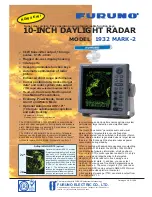
-
37
-
3.2
GPS Data Packet
GPS Data Packets are triggered every second.
Before NMEA messages are available from the external GPS module
Each rising edge of the lidar's internal 1 Hz signal triggers a GPS Data Packet.
The time and date in the GPS Data Packets are unreal, starting from the UTC time 20 05 20 00 00 00 (year, month, day, hour, minute, second) and
increasing with the internal 1 Hz signal.
Once the lidar receives the PPS (pulse-per-second) signal and NMEA messages
The internal 1 Hz signal will be locked to the PPS. Each rising edge still triggers a GPS Data Packet.
Meanwhile, the lidar will extract the actual date and time from NMEA messages ($GPRMC or $GPGGA), and stamp them into both Point Cloud
Data Packets and GPS Data Packets.
· Point Cloud Data Packets: 6-byte Date & Time (year, month, day, hour, minute, second)
· GPS Data Packets: 6-byte Date (year, month, day) and 6-byte Time (second, minute, hour)
The GPS module sends first the PPS signal and then the NMEA message. At the rising edge of the PPS pulse, the corresponding NMEA message is
not yet available. Therefore, the lidar extracts date and time from the previous NMEA message and automatically adds 1 full second.
When GPS signal is lost
The lidar will still trigger GPS Data Packets by the rising edge of the internal 1 Hz signal. However, the GPS time in the packets will be counted by
the internal 1 Hz signal and will drift from the actual GPS time.
Summary of Contents for PandarXT-16
Page 19: ... 17 2 Setup 2 1 Mechanical Installation Figure 2 1 Front View Unit mm ...
Page 20: ... 18 Figure 2 2 Bottom View Unit mm ...
Page 21: ... 19 2 1 1 Recommended Installation Figure 2 3 Recommended Installation ...
Page 28: ... 26 2 3 2 Connection Figure 2 9 Connection Box Connection with GPS ...
Page 29: ... 27 Figure 2 10 Connection Box Connection with PTP ...
















































